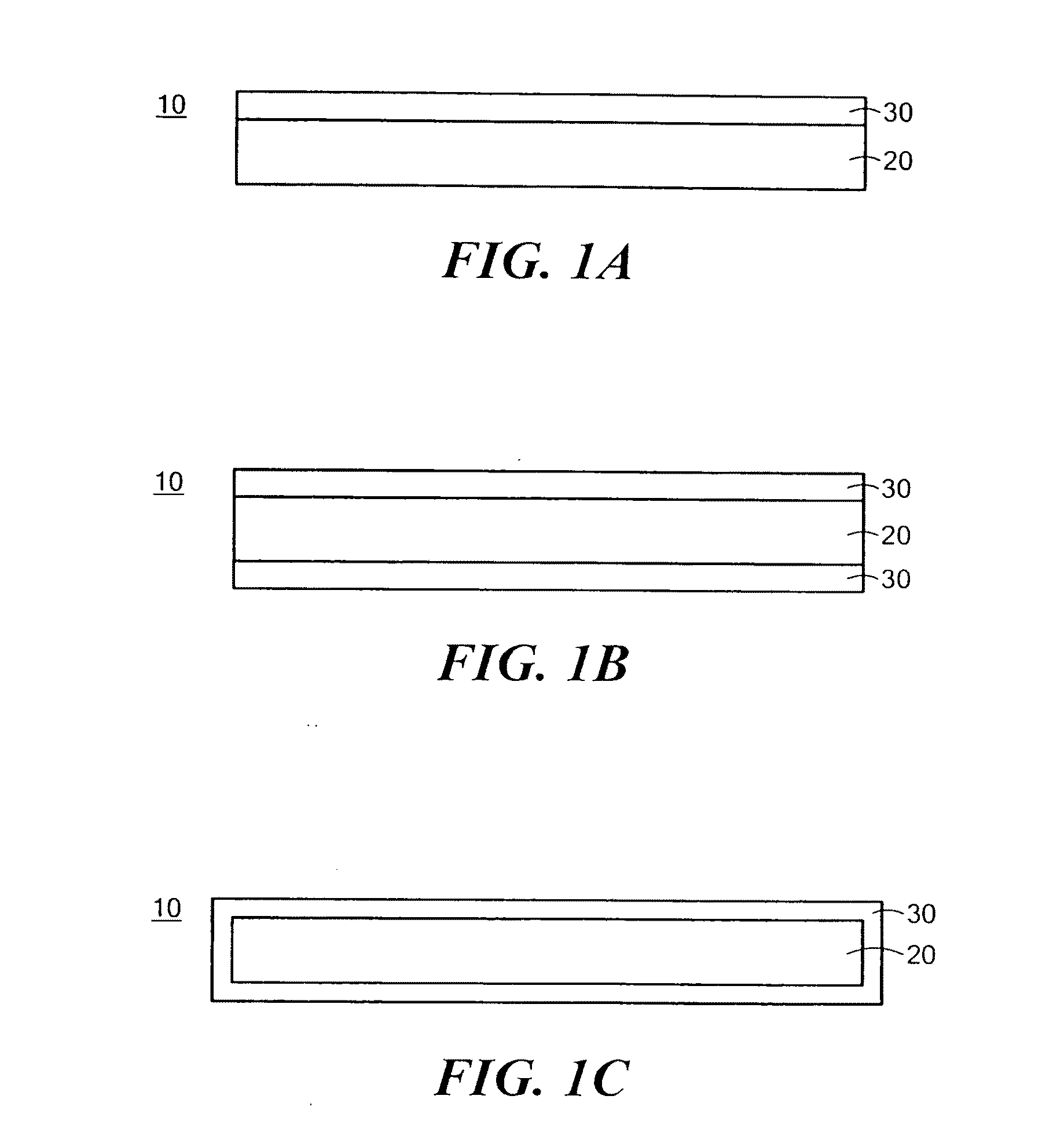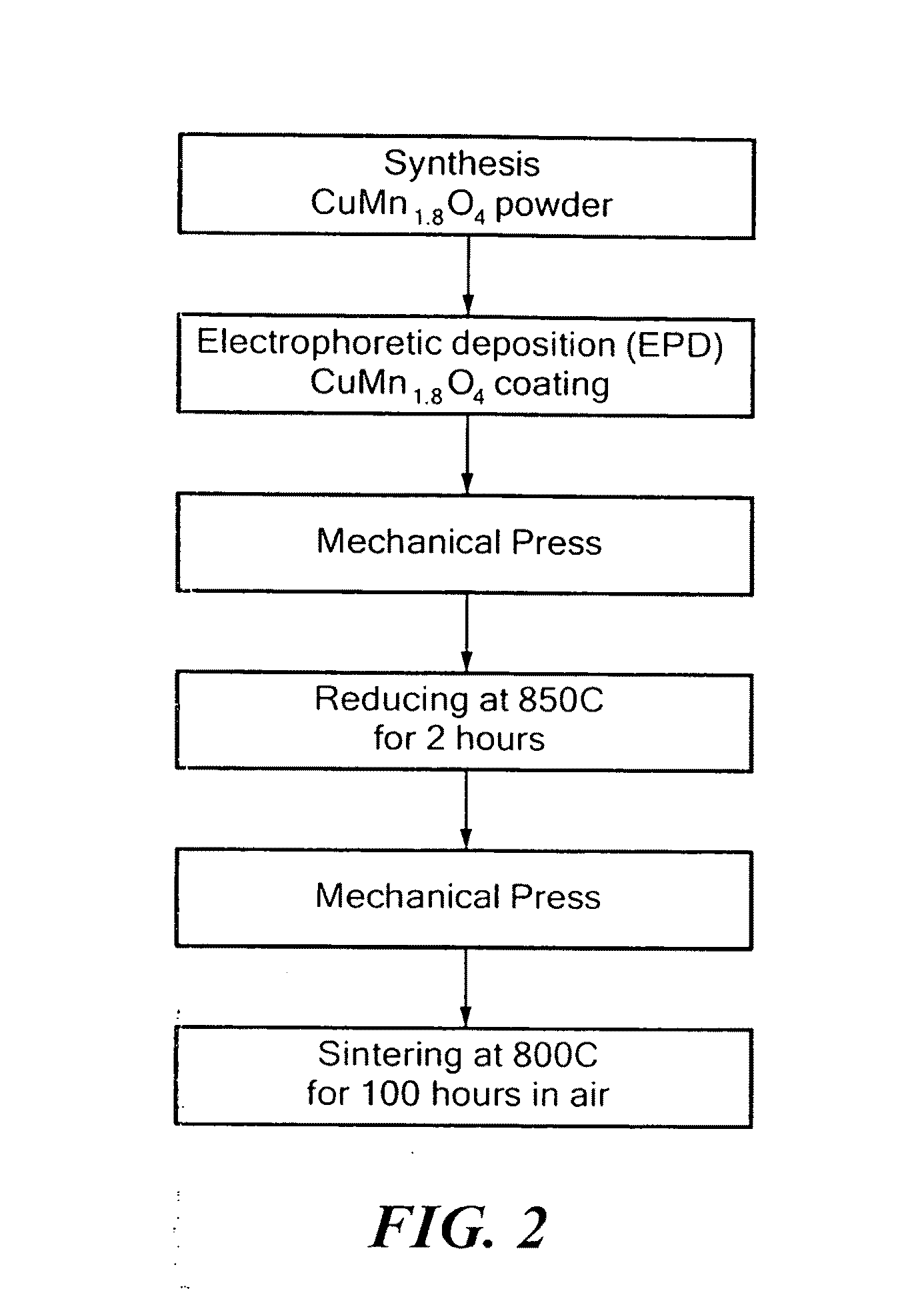Protective oxide coatings for SOFC interconnections
a protective oxide coating and interconnection technology, applied in the direction of fluid pressure measurement, liquid/fluent solid measurement, peptide measurement, etc., can solve the problems of affecting fuel cell performance, affecting the performance of fuel cells, and affecting the conductivity of the coating
- Summary
- Abstract
- Description
- Claims
- Application Information
AI Technical Summary
Problems solved by technology
Method used
Image
Examples
example 1
[0033]A commercial ferritic stainless steel, Crofer 22 APU, with a chemical composition (in wt. %) of 22.8 Cr, 0.45 Mn, 0.08 Ti, 0.06 La, 0.005 C, ≦0.03 P, ≦0.03 S, balance Fe, was used as the substrate for the coating. Crofer 22 APU substrates of dimensions 25 mm×20 mm×0.5 mm were mechanically polished with various grades of SiC paper, up to 1200 grit. Prior to film deposition, the substrates were ultrasonically cleaned in acetone.
[0034]Powders of nominal composition CuMn1.8O4 were prepared by the solid-state reaction method. Proportional amounts of precursors CuO (99.99%) and Mn2O3 (99.9%) were thoroughly mixed and calcined at 1000° C. The calcined powders were crushed and ball-milled, after which the procedure was repeated. The average grain size of the powder used in this experiment was about 0.1 μm. The suspensions of CuMn1.804 spinel used in this study were prepared by mixing the spinel powder in acetone / ethanol (3 / 1 volume ratio) mixture with iodine. The concentration of CuMn...
example 2
[0035]The coatings produced in Example 1 were characterized by X-ray diffraction (XRD) using a Bruker D8 Advance XRD system with Cu Kα radiation. The morphology of the coating was analyzed using scanning electron microscopy (SEM). The oxidation was continuously monitored by thermogravimetry using a TA Q600 thermobalance.
[0036]FIG. 3 shows the representative XRD spectra from the coating as-deposited by EPD, and the coating after sintering at 800° C. for 100 hours in air. The XRD results show that both the as-deposited coating and the coating sintered in air at 800° C. for 100 hours can be indexed to phase-pure CuMn1.8O4 spinel. From the location of the XRD peaks, the lattice parameter of the CuMn1.8O4 spinel phase was calculated to be 8.299 Å, which is slightly smaller than that of stoichiometric CuMn2O4 which has a lattice parameter of 8.305 Å. This is presumably due to the presence of additional manganese vacancies in the former phase.
[0037]The cross-sectional view of CuMn1.8O4 spi...
example 3
[0038]The results of an oxidation study for the CuMn1.8O4-coated Crofer 22 substrates of Example 1 are shown in FIG. 5. Oxidation kinetic measurements were carried out in air at 750° C. or 800° C. by thermogravimetry using a TA Q600 thermobalance. Weight gain for the coated steel was reduced very significantly compared to the uncoated steel. The weight gain of the uncoated and coated steel could be fitted to a near parabolic relationship with time. This is the expected relationship when the oxide scale growth is controlled by coupled diffusion of ions and electrons / holes through a dense scale. A rate constant, kg, characterizing the rate of weight gain, dΔW / dt, as a result of oxidation, can be defined by (ΔW)2=kg t. The observed rate constants are given in Table 1. Assuming the formed scale is Cr2O3, and using the density of bulk Cr2O3, the parabolic rate constant obtained by weight gain can be converted to a thickness change [26]. These rate constants (Table 1) show that at 750° C....
PUM
| Property | Measurement | Unit |
|---|---|---|
| thickness | aaaaa | aaaaa |
| thickness | aaaaa | aaaaa |
| temperature | aaaaa | aaaaa |
Abstract
Description
Claims
Application Information
 Login to View More
Login to View More - R&D
- Intellectual Property
- Life Sciences
- Materials
- Tech Scout
- Unparalleled Data Quality
- Higher Quality Content
- 60% Fewer Hallucinations
Browse by: Latest US Patents, China's latest patents, Technical Efficacy Thesaurus, Application Domain, Technology Topic, Popular Technical Reports.
© 2025 PatSnap. All rights reserved.Legal|Privacy policy|Modern Slavery Act Transparency Statement|Sitemap|About US| Contact US: help@patsnap.com



